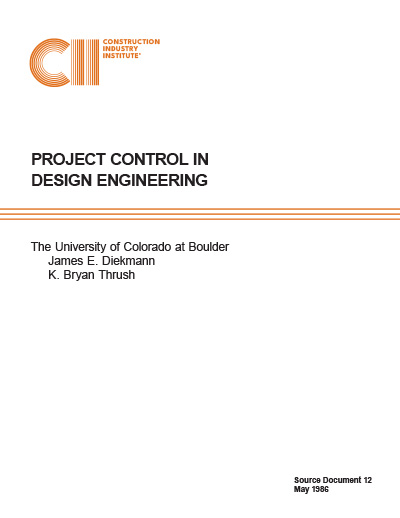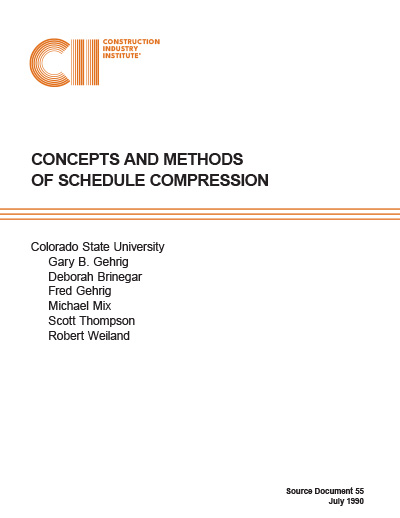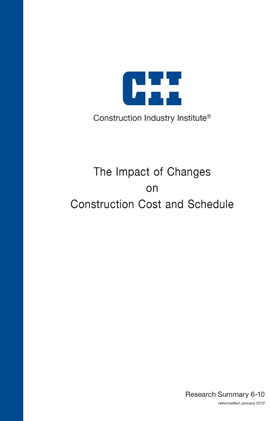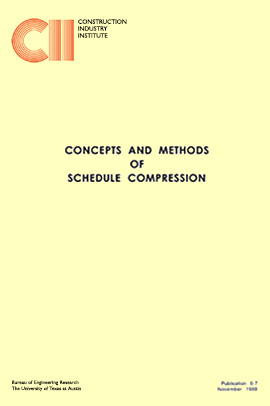
Project Control in Design Engineering
The Construction Industry Institute has been formed to improve the cost effectiveness of the Construction Industry through guided research and training. One facet of industry effectiveness is the management control procedures used on construction projects. Project control is a major key to a profitable project, particularly in the design phase of a project. It is in this phase that the major decisions that affect the project are made. The design not only affects how the project is to be built but also how much it will cost to build the project as designed. Engineering is one of the most common reasons for a project being completed late and over budget. For this reason, the Cost/Schedule Task Force of the Construction Industry Institute has chosen to address the problem of project control in design engineering. It was decided by the Task Force to commission a study of current practices in engineering project controls.
The objectives of this study are fivefold. They are designed to answer five basic questions:
To answer this question project control procedures used by A/E firms and owner companies must be examined and common project control practices determined.
To determine the differences the primary characteristic of design contractor project control procedures must be defined and a comparison between firms produced.
The intent of this objective is to compare different owner approaches to project control and the project control requirements owners place on design contractors.
This study intends to review the project control practices in other project oriented industries and define similarities and differences in techniques and procedures.
It must be determined which contractor system characteristics and which owner system characteristics appear to yield the best results.
- How is project control accomplished?
- What makes one contractor different from another?
- What distinguishes one owner from another?
- Does someone else know something that we don’t?
- This study should answer the question, based on available evidence, how should project control be accomplished?
The objective of this study is to write a report making this information available to the construction industry.
To gather the information needed to accomplish these objectives, personal interviews were conducted with several CII member firms. These interviews were conducted at the firm’s place of business by the authors from August until December, 1984. Six contractors and eight owners were interviewed. The interviewees included project controls managers, scheduling managers, cost managers, and project engineers. The interviews followed a pre-determined set of questions so as to insure uniformity of data. (The interview guide is discussed further in Chapter 3). Upon completion of the interviewing process, the data gathered (including tapes of each interview) was compiled and analyzed and recorded in the following report.
Chapter II is a discussion of the theory behind project control. It is an attempt to provide an overview of the purpose and elements of project control. The presentation is intended to preface the results of the investigation and to provide a common basis for the discussions.
Chapter III contains a summary of the findings of this study of contractor project control procedures and systems. Each finding is presented along with a comparison of the participants and any current trends concerning that finding. A conclusion is also presented based upon available evidence and theory.
Chapter IV is a summary of findings from the owners. The format follows that of Chapter III.
Chapter V is a discussion of project control techniques used in other industries and emerging trends and technologies which may impact the practice of project control.
Chapter VI presents a summary of this study, the conclusions reached, and direction to be taken following this study.
Three appendices have also been included in this report. Appendix I is a detailed narrative of all data collected from each contractor. Appendix II is a detailed narrative of the data collected from each owner. Appendix III presents the procedure and result of the analysis.
This collection of research on design includes CII’s initial research on project control in design engineering. A very important concern in project controls is that of scope definition. The research suggests four key elements for project success: (SD-12, p. 94)
- Organization – Two basic project control approaches to organization; a strong matrix or task-force organization
- Progress Measurement – How to determine if work is progressing at the planned rate
- Schedule – Developing a schedule of the work to be performed is a key element in the planning process.
- Project Control System – To be able to control a project, a system must be developed that provides a framework for collecting, storing, and retrieving all project-related data.
The research identified 21 findings that comprise preliminary indications concerning the effectiveness of project controls related techniques and procedures. Contractors identified 16 of these findings while owners identified five. Details of all 21 can be found in the research materials. A few examples of the findings are listed below.
- Owner – There is a trend to break projects down into several small project elements.
- Owner – The amount of up front planning and information provided in the bid package differs dramatically from firm to firm.
- Contractor – There is an increasing emphasis being placed upon educating project personnel in project controls and on decentralizing project control groups.
- Contractor – There is a trend to controlling work by work packages.
- Contractor – Small computers are the next technological step in project control.
Another key observation from the research is that the lack of project controls is one of the leading factors of an unsuccessful project as identified by contractors. Factors influencing a project are shown below.
Successful Projects
- Well-defined scope
- Early extensive planning
- Good leadership, management, and first line supervision
- Involved positive client relationship
- Project team chemistry
- Quick resolution to changes
- Engineering managers concerned with the total project, not just engineering
Unsuccessful Projects
- Ill-defined scope
- Poor management
- Poor planning
- Communication breakdown between engineering and construction
- Unrealistic scope, schedule, and budget
- Poor quality of project team members
- Many changes
- Lack of good project controls



